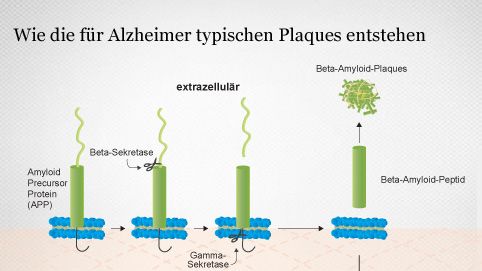Prof. Dr. Christian Haass
PromotionChristian Haass studierte Biologie an der Ruprechts-Karls-Universität Heidelberg und war danach als PostDoc Fellow an der Harvard Medical School (USA). Sein Forschungsschwerpunkt sind zelluläre Mechanismen der Alzheimer Erkrankung.
1995 kehrte Christian Haass nach Deutschland zurück. Hier wirkte er zunächst als Professor am Zentralinstitut für Seelische Gesundheit in Mannheim.
Seit 1999 ist er Professor an der LMU München und Leiter des Adolf-Butenandt Institut. Er ist Kuratoriumsmitglied der Hans und Ilse Breuer Stiftung und Standortsprecher des Deutschen Zentrums für Neurodegenerative Erkrankungen (DZNE) in München. Im Jahr 2000 erhielt er den International Alois Alzheimer Award und war 2002 Träger des Leibniz-Preises.
Arbeitsschwerpunkt:
Molekulare Neurobiologie
Ausbildung:
Biologie Studium
Abschluss:
Promotion
Position / Tätigkeit:
Lehrstuhl für Stoffwechselbiochemie und Leitung des Adolf-Butenant Instituts
Homepage:
http://www.biochemie.abi.med.uni-muenchen.de/haass/index.html
Dormann D, Rodde R, Edbauer D, Bentmann E, Fischer I, Hruscha A, Than ME, Mackenzie IR, Capell A, Schmid B, Neumann M, Haass C. (2010)
ALS-associated fused in sarcoma (FUS) mutations disrupt Transportin-mediated nuclear import. EMBO J.29: 2841-2857.
Paquet D., BrösamleC., Mandelkow E.M., Distel M., Köster R., Schmid B. and Haass C. (2009)
Gal4-UAS based transgenic expression of amyloidogenic proteins allows early detection of disease specific neuropathology in zebrafish. J Clinical Investigation 119: 1382 - 1395.
Willem, M., Garratt, A.N., Novak, B., Citron, M., Kaufmann, S., Rittger, A., DeStrooper, B., Saftig, P., Birchmeier, C. and Haass, C. (2006)
Control of peripheral nerve myelination by the beta-secretase BACE1. Science 314: 664-6.
Fluhrer, R., Grammer, G., Israel, L., Condron, M.M., Haffner, C., Friedmann, E., Bohland, C., Imhof, A., Martoglio, B., Teplow, D.B. and Haass, C. (2006)
A gamma-secretase-like intramembrane cleavage of TNFalpha by the GxGD aspartyl protease SPPL2b. Nat Cell Biol 8:894-6.
Edbauer, D., Winkler, E., Regula, J.T., Pesold, B., Steiner, H. and Haass, C. (2003)
Reconstitution of gamma-secretase activity. Nat Cell Biol 5: 486-8.
Steiner, H., Kostka, M., Romig, H., Basset, G., Pesold, B., Hardy, J., Capell, A., Meyn, L., Grim, M.L., Baumeister, R., Fechteler, K. and Haass, C. (2000)
Glycine 384 is required for presenilin-1 function and is conserved in bacterial polytopic aspartyl proteases. Nat Cell Biol 2: 848-51.
Capell, A., Steiner, H., Romig, H., Keck, S., Baader, M., Grim, M.G., Baumeister, R. and Haass, C. (2000)
Presenilin-1 differentially facilitates endoproteolysis of the beta-amyloid precursor protein and Notch. Nat Cell Biol 2: 205-11.
Haass, C., Lemere, C.A., Capell, A., Citron, M., Seubert, P., Schenk, D., Lannfelt, L. and Selkoe, D.J. (1995)
The Swedish mutation causes early-onset Alzheimer's disease by beta-secretase cleavage within the secretory pathway. Nat Med 1: 1291-6.
Haass, C., Schlossmacher, M.G., Hung, A.Y., Vigo-Pelfrey, C., Mellon, A., Ostaszewski, B.L., Lieberburg, I., Koo, E.H., Schenk, D., Teplow, D.B. and et, al. (1992)
Amyloid beta-peptide is produced by cultured cells during normal metabolism. Nature 359: 322-5.
Haass, C., Koo, E.H., Mellon, A., Hung, A.Y. and Selkoe, D.J. (1992)
Targeting of cell-surface beta-amyloid precursor protein to lysosomes: alternative processing into amyloid-bearing fragments. Nature 357: 500-3.
Ludwig-Maximilians-Universität
UniversitätInstitut:
Adolf Butenandt-Institute
Arbeitsschwerpunkt:
Klinische Neurowissenschaften, Kognitive Neurowissenschaften
Anschrift:
Schillerstrasse 44
88036 München
DE
Telefon:
+49 (0) 89 / 2180 - 0
